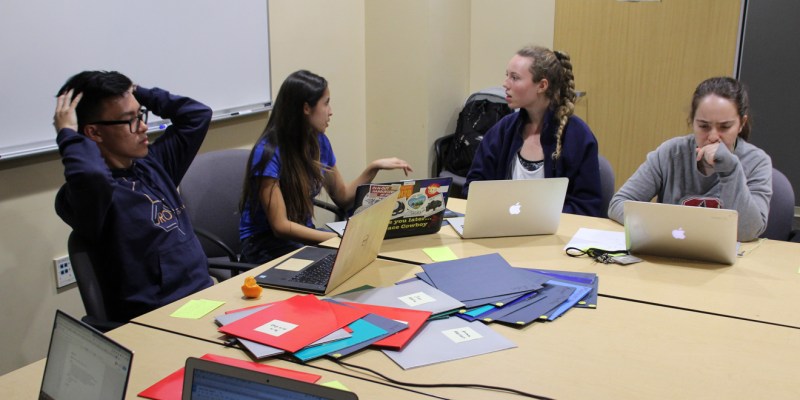Starting this quarter, student-led English language tutoring organization Habla is requiring its tutors to enroll in a brand new, student-run course, CHILATST 1SI: “English Language Learner Tutoring and Curriculum Development.” The class is designed to teach both the lesson planning skills and the individualized approach required to effectively tutor English language learners.
For many years, Habla has brought together Stanford students and janitorial staff in order to give back to the workers by tutoring them in English language and literacy. The organization, which partnered with the Palo Alto Adult School, provided both general group lessons as well as one-on-one time with students during the sessions.
Bilal Choho ’19, a returning tutor from last year who is currently enrolled in the new class, said that Habla activities in the past focused solely on teaching tutees, without placing as much emphasis on training effective tutors. Class sessions would begin with a group lesson for tutees led by a member of the Habla core leadership or an external teacher, followed by some time for tutors and tutee pairs to work on exercises from a grammar textbook together.
But this year, the new one-unit class is at the heart of a change in pedagogy that aims to transform the Habla program as a whole.
“We [tend to] think that if you speak English, you can teach English,” said Sophia Pink ’19, one of the four student instructors for the class. “But it turns out that it’s really, really hard to teach English.”
According to Pink, during her first year in Habla, she and others noticed that students were struggling to effectively teach the language to non-native speakers.
“The purpose of the class is essentially to teach people how to teach English as a second language, because it’s hard and it’s not something that Stanford students, or anyone, was born knowing how to do,” said Pink.
The idea for the course first emerged in conversations with Guadalupe Valdés, a professor at the Graduate School of Education and a founding partner of Understanding Language, an initiative that focuses on English language learning. She has been at Stanford for over 26 years and has been involved on-and-off with student tutor programs such as Habla and Barrio Assistance.
Valdés initially offered to teach one of her previous courses that focused on English-language pedagogy, but the idea of a student-led course garnered greater interest.
“I thought it was a wonderful thing, because it then took it out of being as serious as an academic course,” said Valdés. “Most people who are devoting time to tutoring don’t have time for a serious academic course.”
The final agreement between Valdés and the Habla core had the core take her class first, before teaching the other members of the group what they learned from her.
“They were interested in systematizing some way that young people, who want to work with the workers, are able to improve what they do,” said Valdés.
The new methods used in the tutoring process are based on two preliminary evaluations of the tutee: a needs assessment and a proficiency assessment.
“They tell us what goals they have … and then we have to design our lessons accordingly,” said Choho.
These goals can range from being able to interact with a child’s teacher to understanding what is stipulated in a work contract. Once the concrete goal is established, the tutor gauges the proficiency of the tutee.
“Before I can take you further, I need to find out where you are,” said Valdés.
Valdés also emphasized the importance of self-reflection and self-evaluation on the part of a tutor at the end of a lesson, as well as how important it is to emulate the whole process.
“We go through the whole sequence of, ‘here’s a lesson and here’s how you plan your lesson,’ ‘here’s how you evaluate your lesson’ and ‘here’s how you evaluate your role as a tutor in the end of it,’” said Valdés.
Once a week, the student instructors of the new course teach tutors this new process for them to use in their own lessons, which take place twice a week.
“We spend part of the class time teaching best practices for tutoring English as a second language,” said Pink. “And then we spend half the class time having tutors actually plan out lessons in advance.”
Despite the fact that the new course requirement means an extra hour of involvement for students interested in tutoring the custodial staff, participants say it has not negatively impacted the group’s membership. In fact, Habla had to open a second session of the course because it surpassed the 20-student enrollment cap.
“That tells us something really important – that individuals who want to do this want to do it well,” said Valdés.
According to Choho, that one extra hour of commitment has truly made a difference.
“We have a method and … I think it’s completely necessary,” Choho said. “[It is] a super positive and necessary development because we are really giving much higher quality lessons to our tutees than last year.”
Valdés also mentioned a possible project to digitize the course, which would provide students with recorded samples of exercises and scenarios catered to specific goals, such as improved listening comprehension or conversational skills.
“We’ve really been able to shift our [english as a second language] teaching into the 21st century and have it based on real-world English and real-world skills,” said Pink.
Contact Andrea Villa at acvilla ‘at’ stanford.edu.
